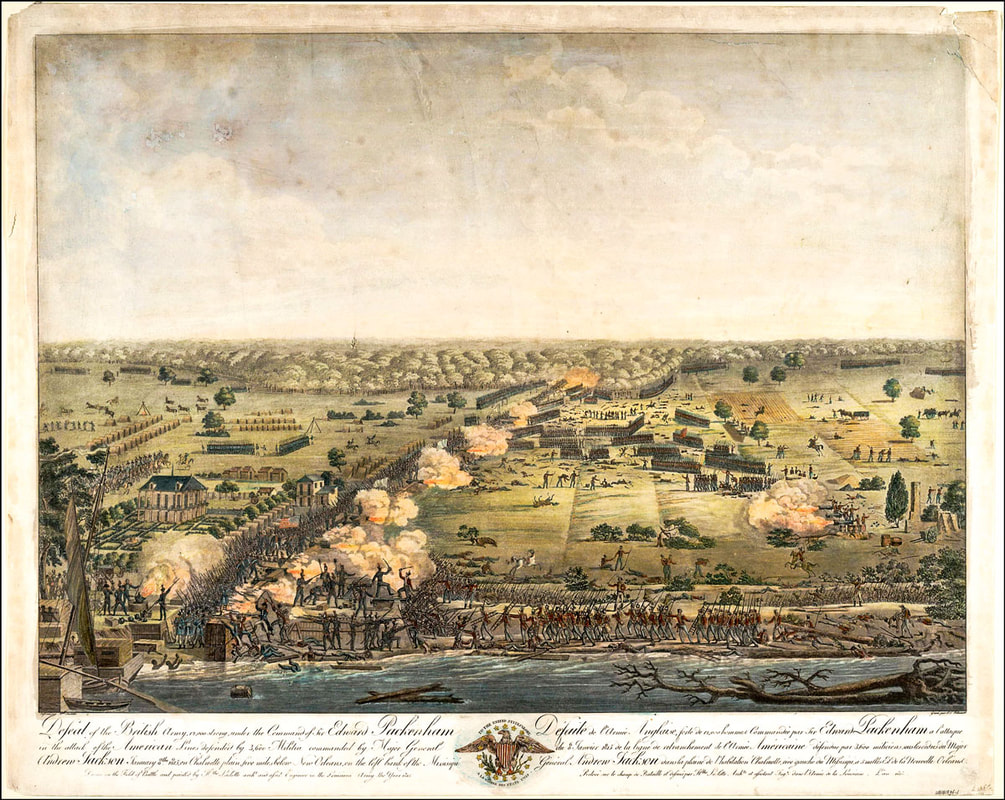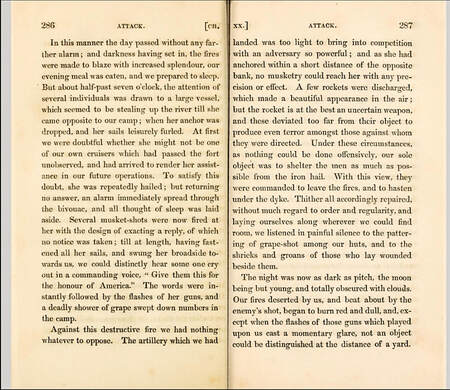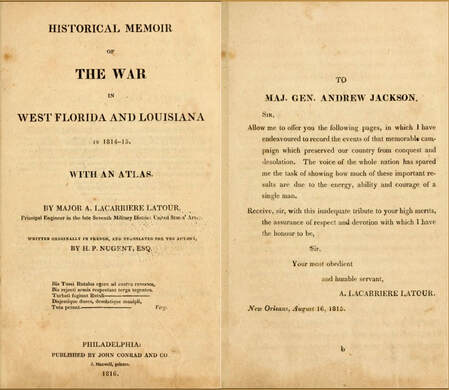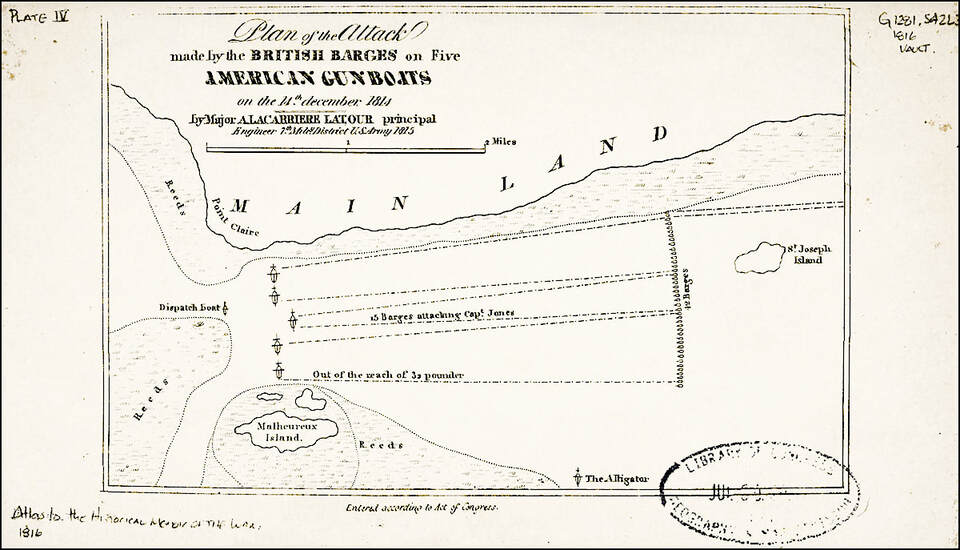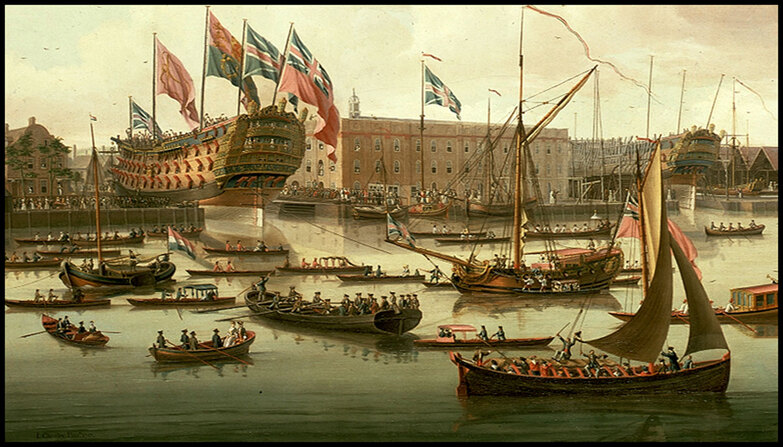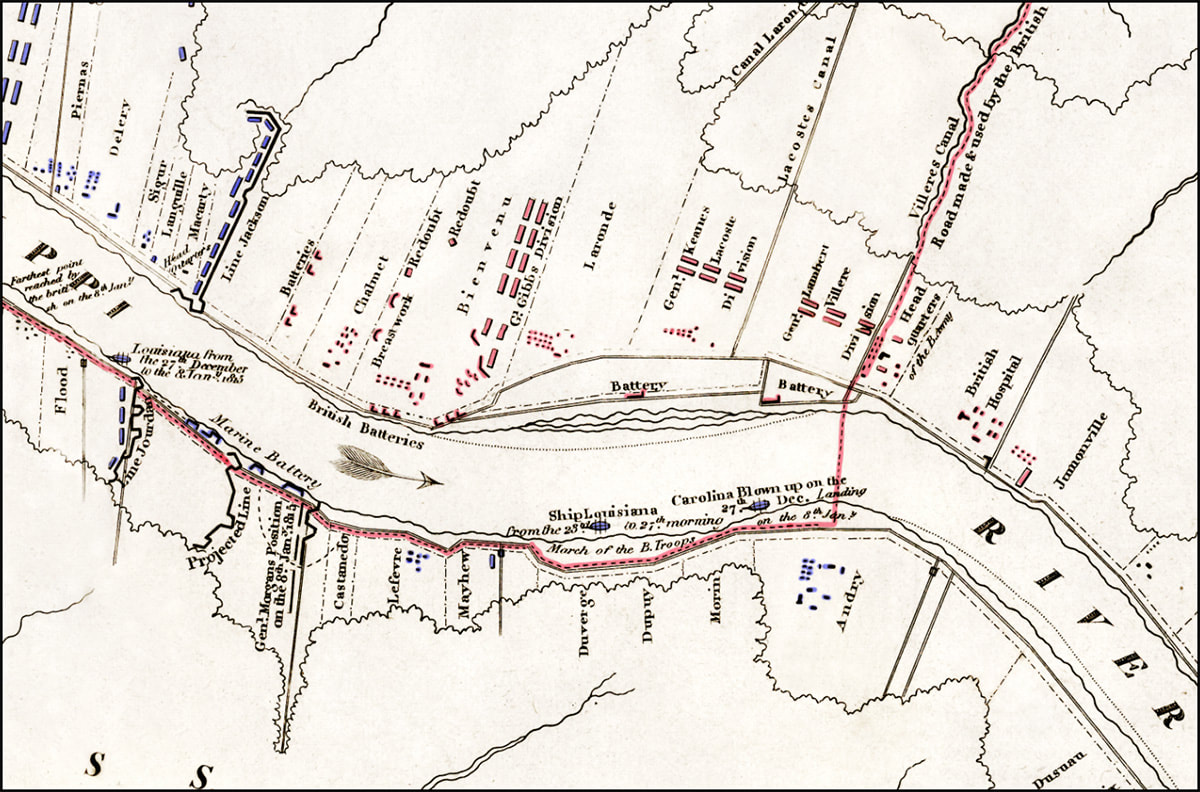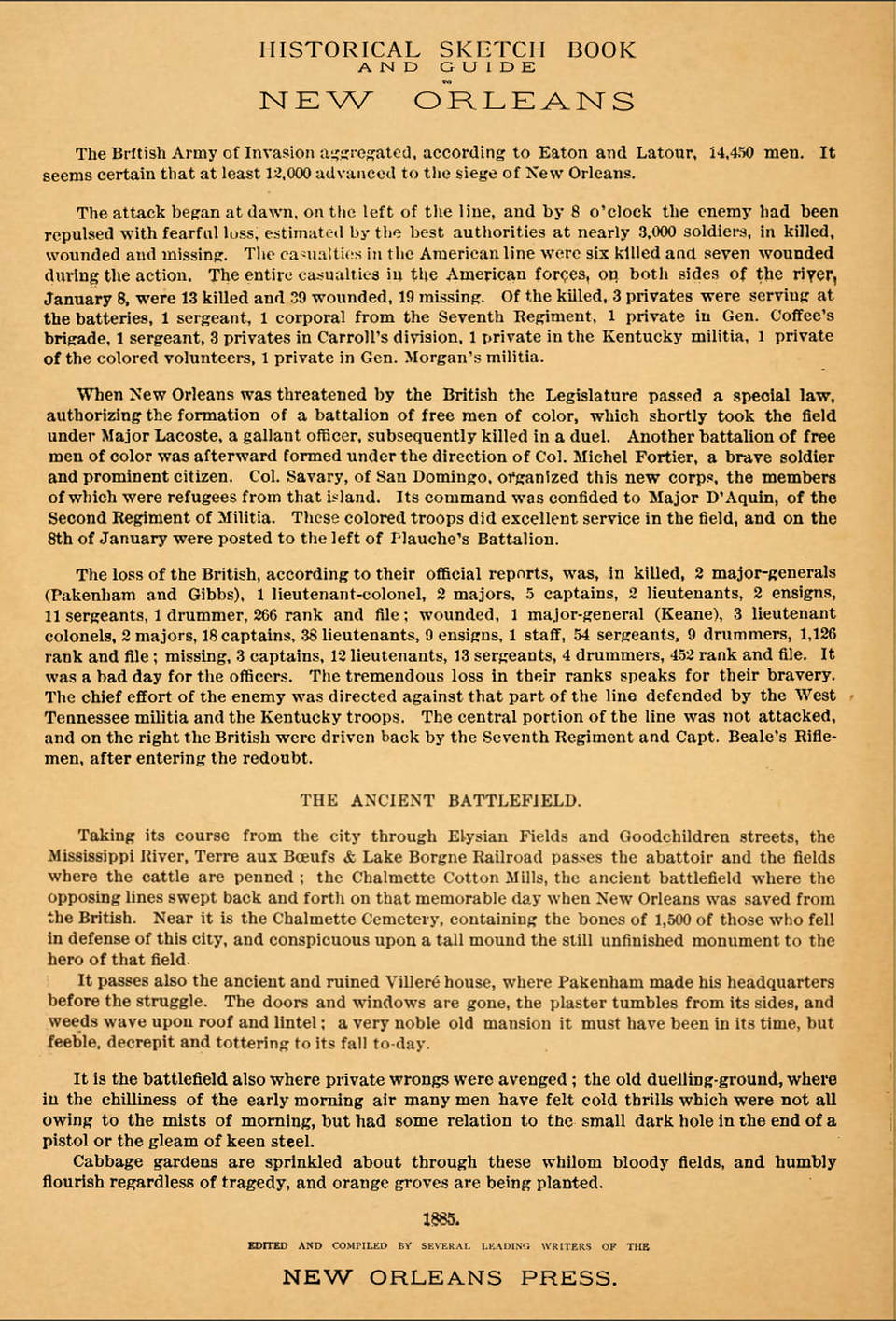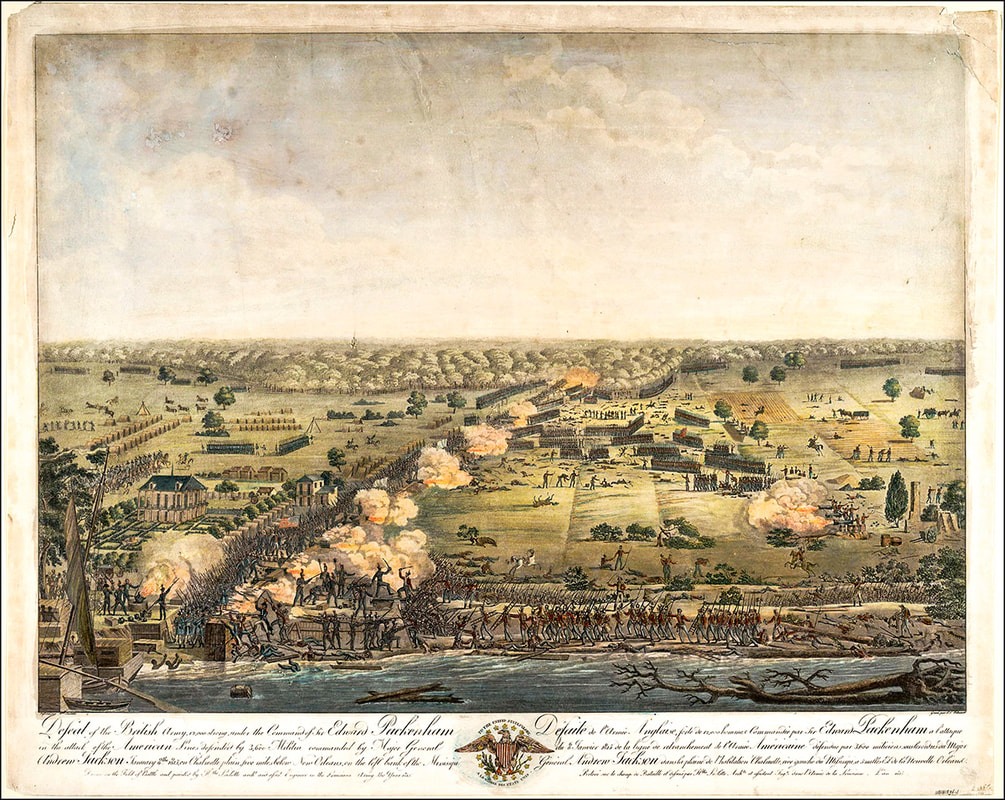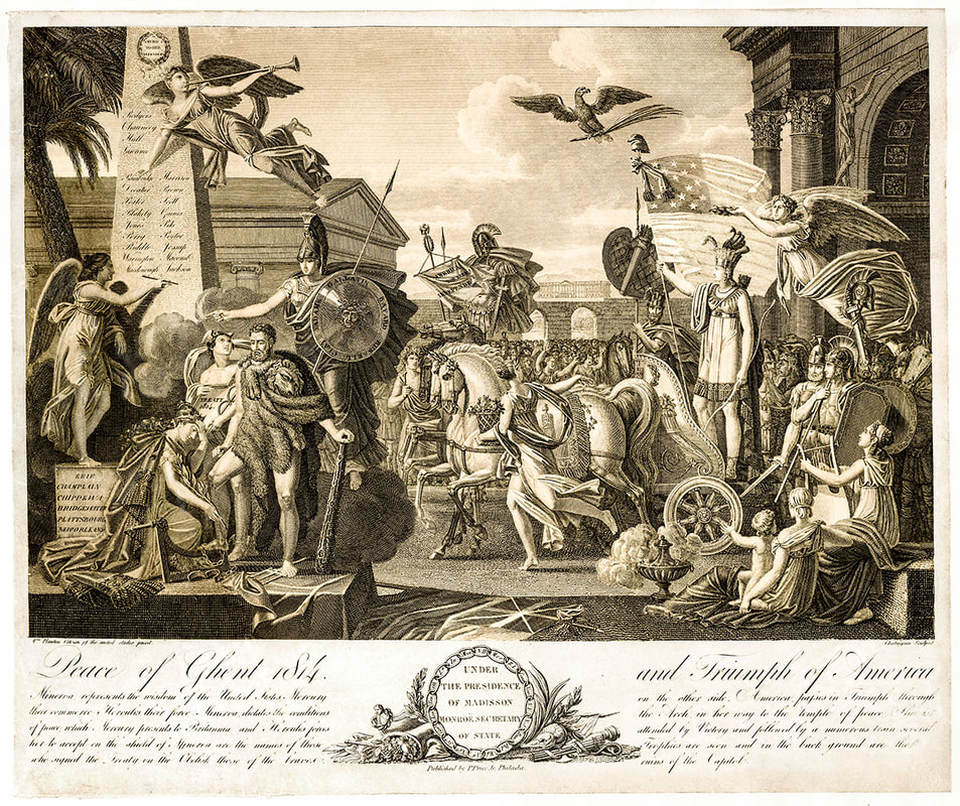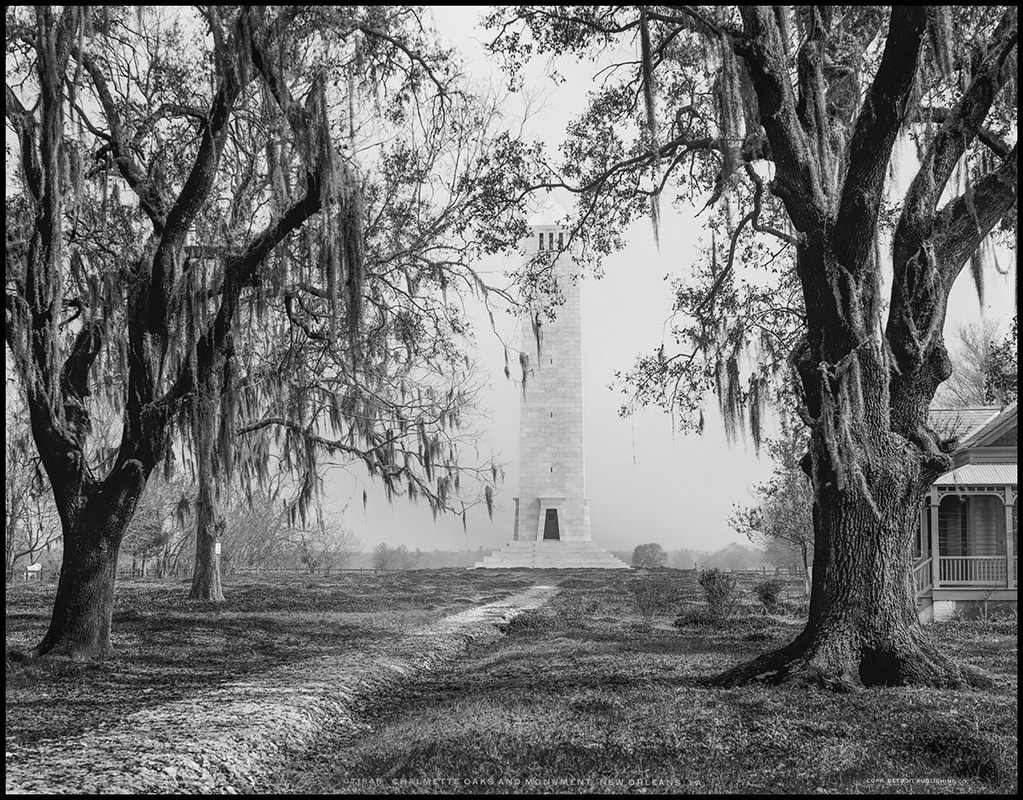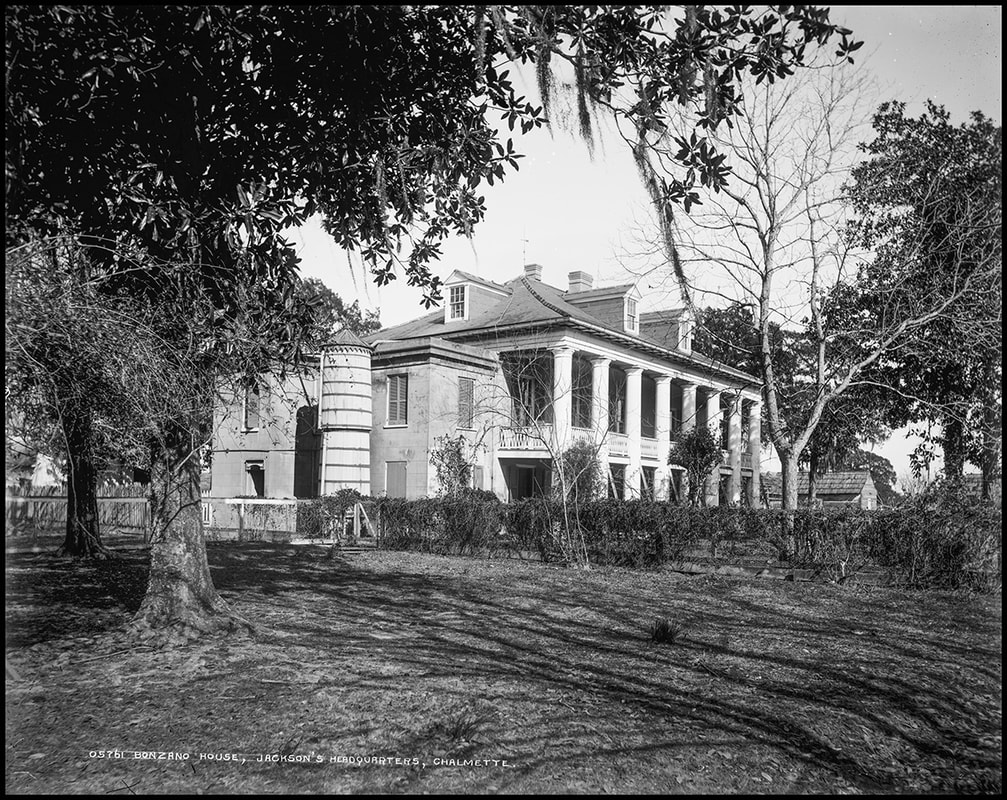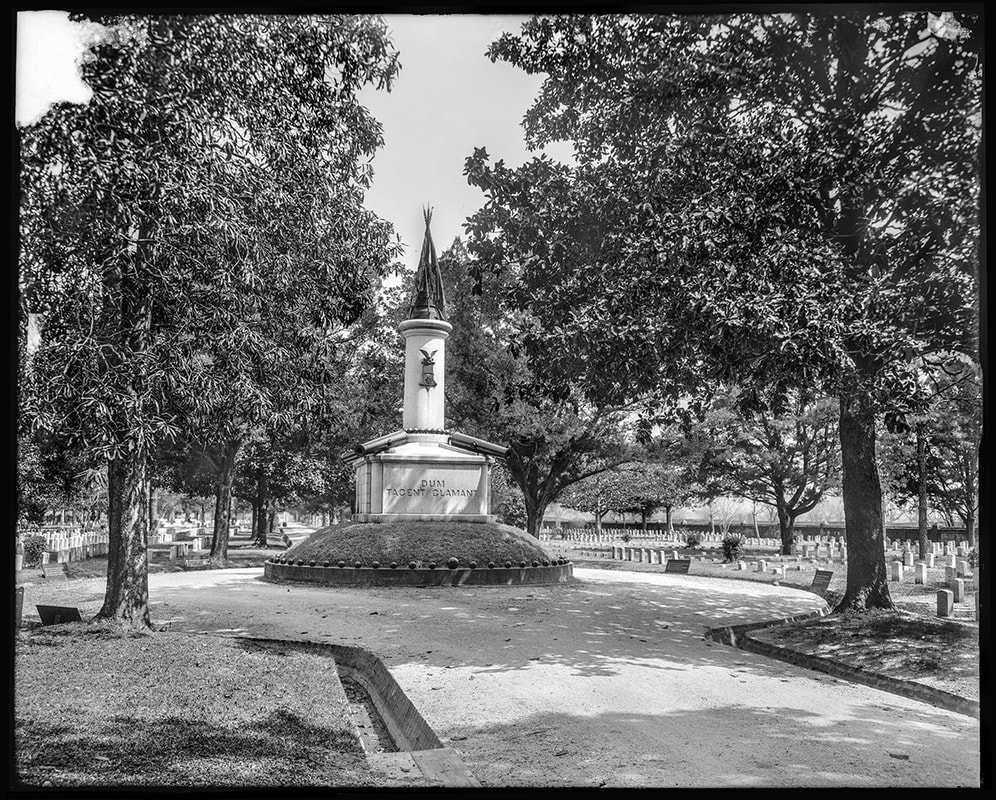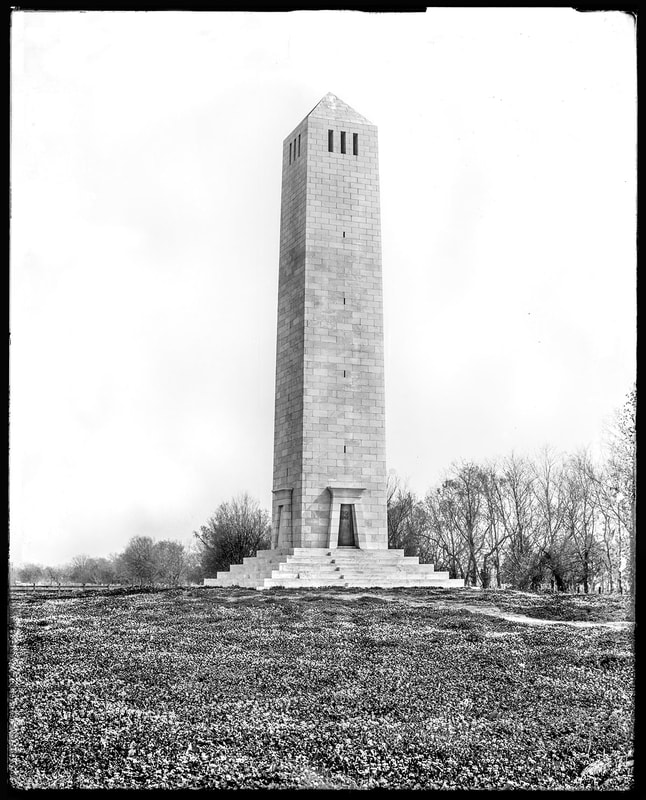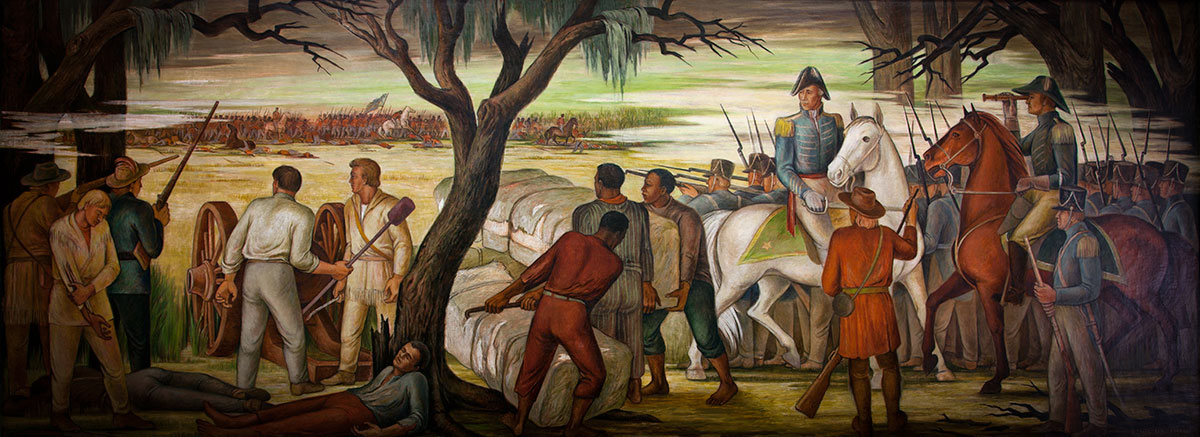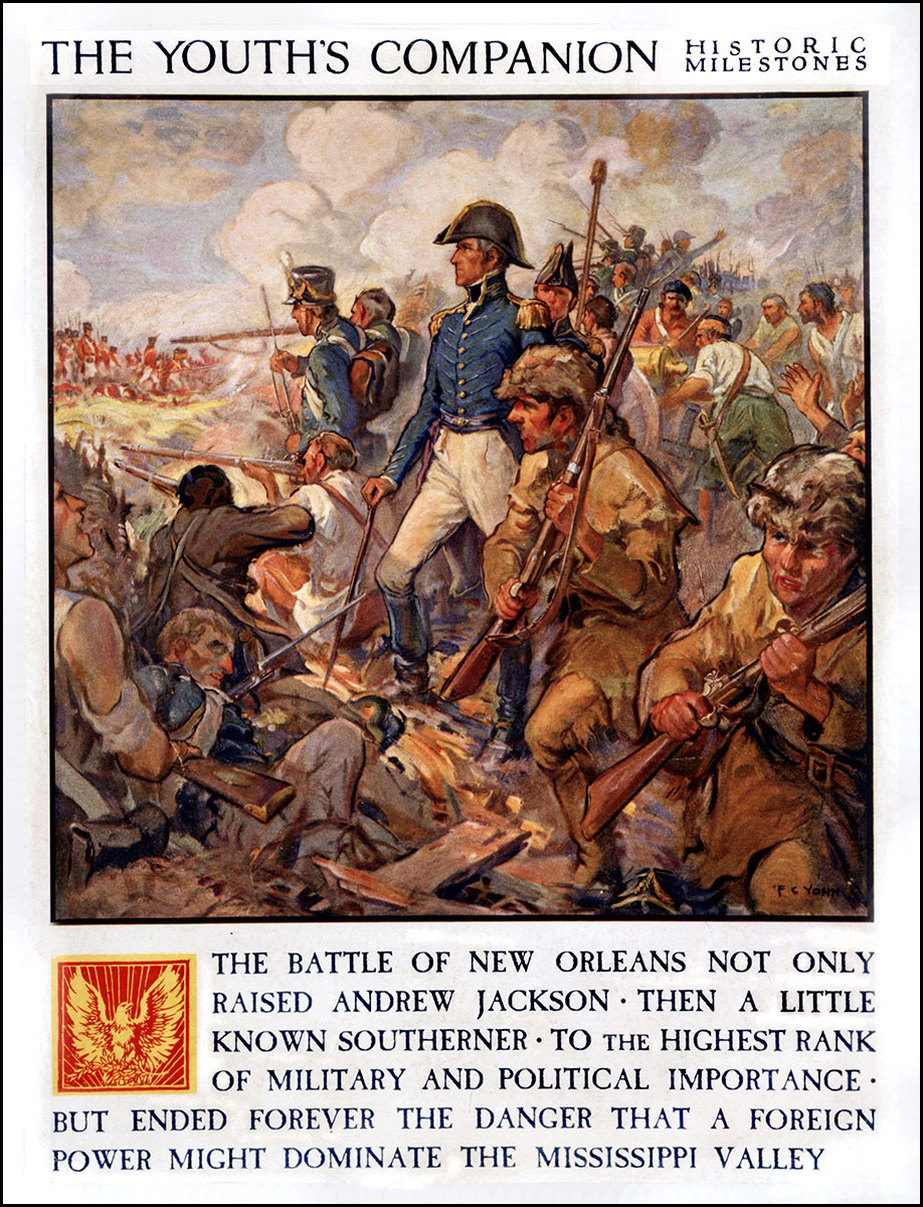The First Battle for New Orleans
December 1814 - January 1815
Two events played a critical role in the fortunes and misadventures of both sides leading up to the British assault on the American fortifications 4 miles south of New Orleans on January 8, 1815 .
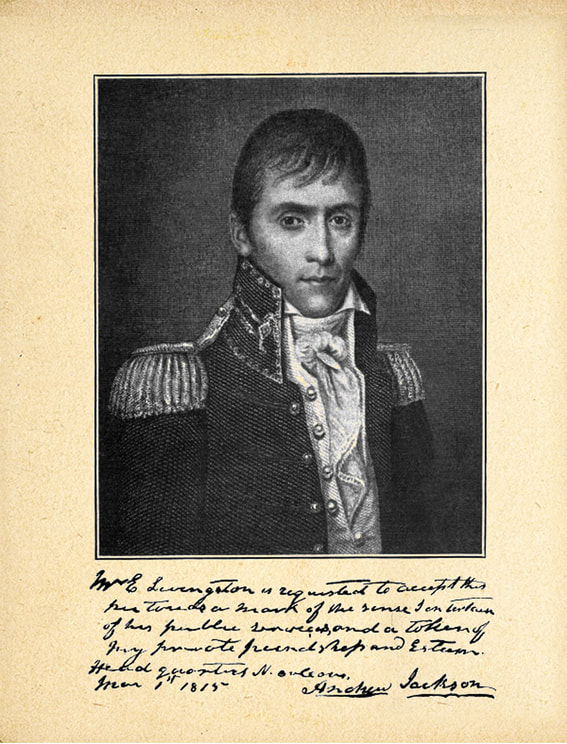
The city of New Orleans was in jeopardy; the control of the Mississippi River trade; the Louisiana Purchase; and the future of the Western frontier- all at risk for the Americans, all to gain for Briton.
The first event was when Jackson lost his Navy on Lake Borgne on December 14th, that would give the British control of Lake Borgne; and access to an uncontested landing just south of the city. But it was the quick response by Jackson to confront the British on the night of December 24th, that stopped the British advance, and gave his army time to construct a line of defense. The night attack was the pivoting moment that determined the future of the city.
"THE JACKSON PORTRAIT GIVEN LIVINGSTON.
This is a Jackson little known. It is engraved from a miniature painted in New Orleans immediately after the battle of New Orleans by Jean Francois Valle, under Jackson's orders. The facsimile of the note that went with it to Edward Livingston explains itself. This portrait bears very small resemblance to the rest of Jacksonian portraits all taken much later by which the inflexible features of the General are imprinted indelibly upon the popular mind."
Stanley Clisby Arthur, Louisiana Historical Society, 1915
The first event was when Jackson lost his Navy on Lake Borgne on December 14th, that would give the British control of Lake Borgne; and access to an uncontested landing just south of the city. But it was the quick response by Jackson to confront the British on the night of December 24th, that stopped the British advance, and gave his army time to construct a line of defense. The night attack was the pivoting moment that determined the future of the city.
"THE JACKSON PORTRAIT GIVEN LIVINGSTON.
This is a Jackson little known. It is engraved from a miniature painted in New Orleans immediately after the battle of New Orleans by Jean Francois Valle, under Jackson's orders. The facsimile of the note that went with it to Edward Livingston explains itself. This portrait bears very small resemblance to the rest of Jacksonian portraits all taken much later by which the inflexible features of the General are imprinted indelibly upon the popular mind."
Stanley Clisby Arthur, Louisiana Historical Society, 1915
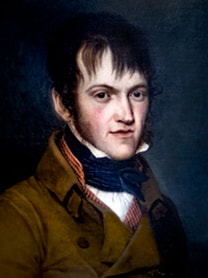 Arsene Lacarriere Latour
Arsene Lacarriere Latour
The source for this narrative is primarily from books by George Robert Gleig, and Major Lacarriere-latour. Their books and maps are linked in PDF format, Internet Archive. Through their lens we see the lost opportunities, or good fortune, being played out on both sides of the conflict.
The naval engagement on Lake Borgne on December 14th, determined that there would be land assault. Captain Jones six gunboats were faster, and well armed, and could have prevented the British from using Lake Borgne to land troops just a few miles south of the city. But the Captain's advantage was lost when the wind died; the tide went out; and two of his gunboats went aground. He couldn't run, he had to make a stand- the British got lucky. Click here for more on Lake Borgne and Captain Jones.
The second turning point was the night engagement on December 24th, and the third was the containment of the British forces until help arrived for the Americans. The ordeal on Lake Borgne was the first blunder for the Americans, and good fortune for the British. The British gained control of Lake Borgne when the Union Jack was raised on all 5 American gunboats. They were employed for transport of British troops; and Jackson lost his eyes on the Lake. General Jackson had no way of knowing where the British would choose to land. Captain Jones’ orders from Commadore Patterson was to avoid contact and surveil; and if engaged, sink or be sunk.
The naval engagement on Lake Borgne on December 14th, determined that there would be land assault. Captain Jones six gunboats were faster, and well armed, and could have prevented the British from using Lake Borgne to land troops just a few miles south of the city. But the Captain's advantage was lost when the wind died; the tide went out; and two of his gunboats went aground. He couldn't run, he had to make a stand- the British got lucky. Click here for more on Lake Borgne and Captain Jones.
The second turning point was the night engagement on December 24th, and the third was the containment of the British forces until help arrived for the Americans. The ordeal on Lake Borgne was the first blunder for the Americans, and good fortune for the British. The British gained control of Lake Borgne when the Union Jack was raised on all 5 American gunboats. They were employed for transport of British troops; and Jackson lost his eyes on the Lake. General Jackson had no way of knowing where the British would choose to land. Captain Jones’ orders from Commadore Patterson was to avoid contact and surveil; and if engaged, sink or be sunk.
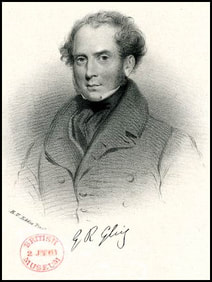 George Robert Gleig
George Robert Gleig
George Gleig’s book dispels a popular local myth that Captain Jones' blockade delayed the British landing, that gave General Jackson time to build fortifications to defend the city. Gleig provides the circumstance that caused the British delay. It took eight days to make four round trips to transport the British forces of 8000 men, and their equipment, from the Fleet at anchor in the Ship Island straight to Pea Island. One trip for the sailors rowing the barges was a 36-hour haul.
Lacarriere Latour, Jackson’s chief engineer, points out that the British invasion route wasn’t known to Jackson until mid-day on the 23rd; nine days after the blockade attempt. Fortifications on the Jackson Line began on the morning of the 24th, after Jackson's surprise night attack on the British the night before.
Lacarriere Latour, Jackson’s chief engineer, points out that the British invasion route wasn’t known to Jackson until mid-day on the 23rd; nine days after the blockade attempt. Fortifications on the Jackson Line began on the morning of the 24th, after Jackson's surprise night attack on the British the night before.
THE CAMPAIGNS OF THE BRITISH ARMY AT WASHINGTON AND NEW ORLEANS,
|
Historical Memoir of the War in West Florida and Louisiana in 1814-15
|
The Navel Engagement on Lake Borgne, December 14, 1814
https://en.wikipedia.org/wiki/Battle_of_Lake_Borgne
https://en.wikipedia.org/wiki/Battle_of_Lake_Borgne
 Click on map to zoom in.
Click on map to zoom in.
The British campaign to advance on New Orleans is highlighted in red, and the American fortifications along the Mississippi River defending New Orleans is highlighted in blue. The map shows the advance of the British navy up the mouth of the Mississippi River to the fortified battery at Fort St. Philip, and the British troop movements by barge across Lake Borgne, and their retreat back to the main British fleet anchorage in the straights of Ship Island. The map also shows the march of General Jackson's troops in his expedition against Pensacola.
Click the map to zoom view
The British perspective
“Our view of the matter accordingly was, that some fifteen or twenty thousand men would be forthwith embarked on board of ship and transported to the other side of the Atlantic; that the war would there be carried on with a vigour conformable to the dignity and resources of the country which waged it; and that no mention of peace would be made till our generals should be in a situation to dictate its conditions in the enemy's capital.” p. 4
“Our view of the matter accordingly was, that some fifteen or twenty thousand men would be forthwith embarked on board of ship and transported to the other side of the Atlantic; that the war would there be carried on with a vigour conformable to the dignity and resources of the country which waged it; and that no mention of peace would be made till our generals should be in a situation to dictate its conditions in the enemy's capital.” p. 4
"……the white flag had hardly been hoisted on the citadel of Bayonne, when a rumour became prevalent that an extensive encampment of troops, destined for the American war, was actually forming in the vicinity of Bourdeaux. A variety of causes led me to anticipate that the corps to which I was attached would certainly be employed upon that service." p. 5
“…….it was the 10th of December before the shores of America could be discerned. On that day we found ourselves opposite to the Chandeleur Islands, and near the entrance of Lake Borgne. p. 252
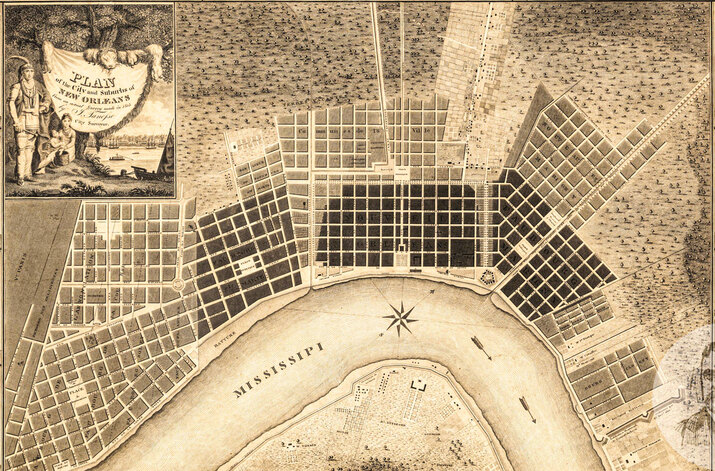 Map of New Orleans, Louisiana in 1817
Map of New Orleans, Louisiana in 1817
“New Orleans is a town of some note…… Though in itself unfortified, it is difficult to conceive a place capable of presenting greater obstacles to an invader…. Built upon a narrow neck of land, which is confined on one side by the river, and on the other by impassable morasses, its means of defence require little explanation….” p. 252
"To approach by the river is out of the question, and therefore an enemy can land only from the Lake. But this can be done nowhere, except where creeks or bayos offer conveniences for that purpose, because the banks of the Lake are universally swampy; and can hardly supply footing for infantry, far less for the transportation of artillery.” The Campaign of the British Army at Washington and New Orleans in the years 1814—1815, George Robert Gleig, p. 259
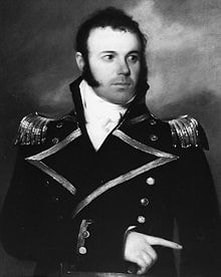 Commodore Daniel Patterson
Commodore Daniel Patterson
The American perspective
“Commodore Daniel T. Patterson, commanding the New Orleans station, had received from Pensacola, a letter, dated the 5th of December, informing him of the arrival of sixty sail of British vessels, and of a still greater number being expected; that those vessels had on board a considerable number of troops destined to act against New Orleans.”
"In the evening of the 13th of December, commodore Patterson received information that the naval forces of the enemy at anchor at Ship Island, were increased to thirty sails, of which six were ships of the line; that others were every moment arriving, especially a number of light vessels, calculated for navigating on our coast where there is but little water, and that the enemy appeared to be sounding the passes." "The arrival of a great number of the enemy's ships of various force on our eastern coast, sufficiently announced the intention of the British, soon to make an attack in this quarter."
“Commodore Daniel T. Patterson, commanding the New Orleans station, had received from Pensacola, a letter, dated the 5th of December, informing him of the arrival of sixty sail of British vessels, and of a still greater number being expected; that those vessels had on board a considerable number of troops destined to act against New Orleans.”
"In the evening of the 13th of December, commodore Patterson received information that the naval forces of the enemy at anchor at Ship Island, were increased to thirty sails, of which six were ships of the line; that others were every moment arriving, especially a number of light vessels, calculated for navigating on our coast where there is but little water, and that the enemy appeared to be sounding the passes." "The arrival of a great number of the enemy's ships of various force on our eastern coast, sufficiently announced the intention of the British, soon to make an attack in this quarter."
"Commodore Patterson had sent five gun-boats, one tender, and a dispatch boat, towards the passes Mariana and Christiana……..The command of this flotilla was given to Thomas Asp. Catesby Jones, who hoisted his flag on board gun-boat No. 156. Commodore Patterson's instructions directed that, if possible, it would be well to wait for the enemy's barges, launches, and pinnaces on the outside of the Rigolets; that perhaps the enemy would endevour to cut off the gun-boats with his small craft, and that if his forces were too considerable, it was not advisable to remain too long at the same anchoring ground, at that time between Ship and Cat islands, and that it was important to secure a retreat at the Rigolets, where they must wait for the enemy, and sink him or be sunk. The commodore particularly recommended the most vigilant attention in watching the enemy's movements………" Historical Memoir of the war in West Florida and Louisiana in 1814-15, Major A. Lacarriere Latour
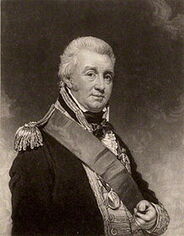 Vice Admiral Sir Alexander Cochrane
Vice Admiral Sir Alexander Cochrane
On December 9, British Commander Vice Admiral Sir Alexander Cochrane's fleet was sighted off the Louisiana coast. The British had three warships, HMS Seahorse, Armide and Sophie sailing for Lake Borgne to secure a beachhead for the troopships for the assault on New Orleans. There was some light resistance from American gunboats around Cat Island Pass off the coast of Mississippi. On their approach to Lake Borgne, the British encountered the American schooner Sea Horse who was on a mission to destroy a powder magazine at Bay St. Louis in order to prevent its capture. The schooner, with the protection of a shore battery, fought off two longboat attacks but was burnt later that night to prevent her capture by the British.
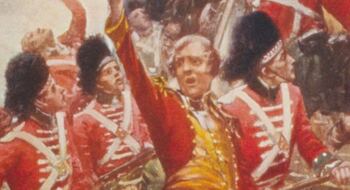 General John Keane
General John Keane
“Sir Alexander Cochrane and General John Keane determined to effect a landing somewhere on the banks of the Lake; and pushing directly on, to take possession of the town, before any effectual preparation could be made for its defence….. With this view the troops were removed from the larger into the lighter vessels, and these, under convoy of such gun-brigs as the shallowness of the water would float, began on the 13th to enter Lake Borgne. But we had not proceeded far, when it was apparent that the Americans were well acquainted with our intentions, and ready to receive us. Five large cutters, armed with six heavy guns each, were seen at anchor in the distances; and as all endeavours to land, till these were captured, would have been useless, the transports and largest of the gun- brigs cast anchor, whilst the smaller craft gave chase to the enemy.” p, 261
"But these cutters were built purposely to act upon the Lake. They accordingly set sail, as soon as the English cruizers arrived within a certain distance, and running on, were quickly out of sight, leaving the pursuers fast aground. To permit them to remain in the hands of the enemy, however, would be fatal, because, as long as they commanded the navigation of the Lake, no boats could venture to cross." p, 262
“This flotilla consisted of fifty open boats; most of them armed with a carronade in the bow, and well manned with volunteers from the different ships of war. The command was given to Captain Lockier, a brave and skilful officer, who immediately pushed off; and about noon came in sight of the enemy, moored fore and aft, with broadsides pointing towards him. Having pulled a considerable distance, he resolved to refresh his men before he hurried them into action; and, accordingly, letting fall grapplings just beyond the reach of the enemy's guns, the crews of the different boats coolly ate their dinner. As soon as that meal was finished, and an hour spent in resting, the boats again got ready to advance. But unfortunately, a light breeze which had hitherto favoured them, now ceased to blow, and they were in consequence compelled to make way only with the oar. The tide also ran strong against them, at once increasing their labour and retarding their progress; but all these difficulties appeared trifling to British sailors; and, giving a hearty cheer, they moved steadily onward in one extended line.” p.262
“It was not long before the enemy's guns opened upon them, and a tremendous shower of balls saluted their approach. Some boats were sunk, others disabled, and many men were killed and wounded; but the rest pulling with all their might and occasionally returning the discharges from their carronades, succeeded, after an hour's labour, in closing with the Americans. The marines now began a deadly fire of musketry; whilst the seamen, sword in hand, sprang up the vessels' sides in spite of all opposition; and sabering every man that stood in their way, hauled down the American ensign, and hoisted the British flag in its place”. p. 263-64
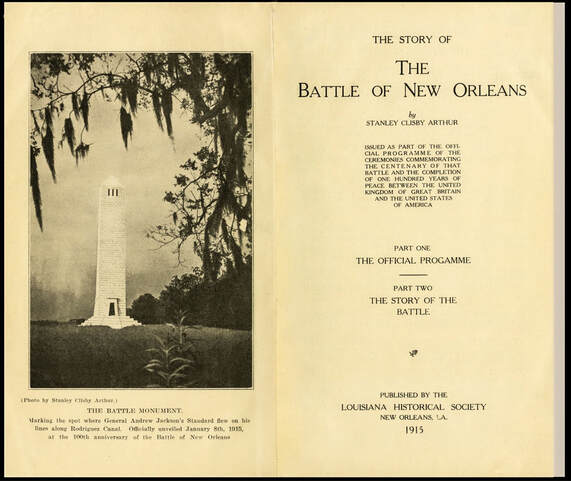 Click anywhere on the book to zoom and read.
Click anywhere on the book to zoom and read.
"And yet their victory was one of great value and importance. It not only cleared Lake Borgne of all enemies, but supplied Sir Alexander Cochrane with a very important addition to his fleet of smaller vessels, so much needed in effecting a landing of the army. It was late in the afternoon when the barges and gunboats returned to Ship Island. On their appearance they were loudly cheered by the sailors and soldiers of the ships; but they were too much wearied and oppressed by the severity of their loss, to give more than a feeble and faint response. It was more like a wail than a cheer. The wounded were removed to a large store-ship, the Gorgon, where the Americans were attended by the same surgeons who ministered the British.
These results show that the victory of the British was a costly one. There was not much rejoicing and exultation over it. The groans and cries of the wounded were the prevalent notes in that melancholy squadron as it returned to the anchorage of the British fleet. The Battle of New Orleans, Louisiana Historical Society, Stanley Arthur, 1915
https://archive.org/details/storyofbattlenew00arth/page/64/mode/2up
These results show that the victory of the British was a costly one. There was not much rejoicing and exultation over it. The groans and cries of the wounded were the prevalent notes in that melancholy squadron as it returned to the anchorage of the British fleet. The Battle of New Orleans, Louisiana Historical Society, Stanley Arthur, 1915
https://archive.org/details/storyofbattlenew00arth/page/64/mode/2up
"The enemy's cutters having fallen into our hands, at an early hour on the morning of the 16th the disembarkation of the troops began. So deficient, however, was the fleet in boats and other small craft fit to navigate the lakes, that it was late on the evening of the 21st, before the last divi- sion took up its ground upon Pine Island, and even then the inconveniences of descent were not beginning. The troops had yet to be arranged in corps and brigades; to each of these its proportion of commissaries, purveyors and medical attendants, etc., etc., required to be allotted, and some at- tempt at estabfishing depots of provisions and military stores had to be made. In adjusting these matters the whole of the 22nd A'as occupied, on which day General Keane like- wise reviewtid the whole of the army. This being ended the force was- next distributed into divisions or corps and the following is the order it assumed." The Battle of New Orleans, Louisiana Historical Society, Stanley Arthur, 1915
https://archive.org/details/storyofbattlenew00arth/page/80/mode/2up
https://archive.org/details/storyofbattlenew00arth/page/80/mode/2up
“Night and day were boats pulling from the fleet to the island, and from the island to the fleet; for it was the 2Lst before all the troops were got on shore…..” (Pea Island) p. 267“Having destroyed all opposition in this quarter, the fleet again weighed anchor, and stood up the Lake….. But we had not been many hours under sail, when ship after ship ran aground…. till finally the lightest vessel stuck fast; and the boats were of necessity hoisted out, to carry us a distance of upwards of thirty miles. “……it was found that there were not, throughout the whole fleet, a sufficient number of boats to transport above one-third of the army at a time.” p. 273
….. and each division, after an exposure of ten hours, landed upon a small desert spot of earth, called Pine Island, where it was determined to collect the whole army, previous to its crossing over to the main.” p. 264-65
….. and each division, after an exposure of ten hours, landed upon a small desert spot of earth, called Pine Island, where it was determined to collect the whole army, previous to its crossing over to the main.” p. 264-65
The British generals “…. resolved to lose no time in bringing their army into the field, in the best manner which circumstances would permit.…..the advance, consisting of 1600 men and two pieces of cannon, was next morning embarked." 22nd December p. 274
“When we set sail, the sky was dark and lowering, and before long a heavy rain began to fall. Continuing without intermission during the whole of the day, towards night, it, as usual, ceased, and was succeeded by a sharp frost; which, taking effect upon men thoroughly exposed, and already cramped by remaining so long in one posture, rendered our limbs completely powerless. Nor was there any means of dispelling the benumbing sensation, or effectually resisting the cold….. Having remained in this uncomfortable state till midnight, the boats cast anchor……. to dispatch a small piquet of Americans at the entrance of the creek… took them all fast asleep, without noise or resistance. …. the flotilla again weighed anchor “……we reached the entrance of the creek by dawn; and about nine o'clock, were safely on shore.” p. 275-76
“The deserters who had come in, and accompanied us as guides, they were actually Portuguese and Spanish fishermen assured the General that he had only to show him-self, when the whole district would submit. p.277
"On the 21st of December, a detachment of militia, consisting of eight white men and a sergeant, two mulattoes and one negro, with a single boat, was sent by major Villerie (the son) to the village of the Spanish fishermen, on the left bank of the bayou Bienvenu, a mile and a half from its entrance into lake Borgne, for the purpose of discovering whether the enemy might try to penetrate that way, and to give notice of such attempt." Historical Memoir of the war in West Florida and Louisiana in 1814-15, Major A. Lacarriere Latour
“The deserters who had come in, and accompanied us as guides, they were actually Portuguese and Spanish fishermen assured the General that he had only to show him-self, when the whole district would submit. p.277
"On the 21st of December, a detachment of militia, consisting of eight white men and a sergeant, two mulattoes and one negro, with a single boat, was sent by major Villerie (the son) to the village of the Spanish fishermen, on the left bank of the bayou Bienvenu, a mile and a half from its entrance into lake Borgne, for the purpose of discovering whether the enemy might try to penetrate that way, and to give notice of such attempt." Historical Memoir of the war in West Florida and Louisiana in 1814-15, Major A. Lacarriere Latour
On December 11th, Admiral Cochrane ordered the British naval forces to run down and defeat the American flotilla. On the night of December 12th, the British deployed 14 warships, 1200 sailors, and Royal Marines, 42 longboats, launches and barges to Lake Borgne to run at the American blockade.
On their approach to Lake Borgne, the British encountered the American schooner Sea Horse who was on a mission to destroy a powder magazine at Bay St. Louis in order to prevent its capture. The schooner, with the protection of a shore battery, fought off two longboat attacks but was burnt later that night to prevent her capture by the British.
On their approach to Lake Borgne, the British encountered the American schooner Sea Horse who was on a mission to destroy a powder magazine at Bay St. Louis in order to prevent its capture. The schooner, with the protection of a shore battery, fought off two longboat attacks but was burnt later that night to prevent her capture by the British.
"On the morning of the 14th, the British rowed their boats into the current until they were about two miles away where they anchored to take tea (breakfast) and rest before attacking. About 10:30 they closed on the brave little fleet under the command of Lt. Thomas Ap Catesby Jones. By 12:40 the battle was over. Six Americans were dead and 35 were wounded. The British suffered 17 dead and 77 wounded……..and a few days afterwards the fate of the gun-boats was known." Historical Memoir of the war in West Florida and Louisiana in 1814-15, Major A. Lacarriere Latour
The Americans were able to sink two of the attacking longboats and damaging many others, but eventually, the range closed, and the British sailors and marines were able to board the American vessels. The British captured the flagship gunboat and turned her guns against her sister ships. The Tickler, a small fifty-ton sloop anchored a short distance behind the five gunboats, was scuttled and burned to avoid capture. The British assault on the American blockade lasted about 2 hours, with the hand-to-hand combat lasting only about 5 minutes. The American seamen surrendered, and the gunboats pressed into service by the British. Lake Borgne would become the landing zone for British forces preparing to attack New Orleans. https://en.wikipedia.org/wiki/Battle_of_New_Orleans
The Americans were able to sink two of the attacking longboats and damaging many others, but eventually, the range closed, and the British sailors and marines were able to board the American vessels. The British captured the flagship gunboat and turned her guns against her sister ships. The Tickler, a small fifty-ton sloop anchored a short distance behind the five gunboats, was scuttled and burned to avoid capture. The British assault on the American blockade lasted about 2 hours, with the hand-to-hand combat lasting only about 5 minutes. The American seamen surrendered, and the gunboats pressed into service by the British. Lake Borgne would become the landing zone for British forces preparing to attack New Orleans. https://en.wikipedia.org/wiki/Battle_of_New_Orleans
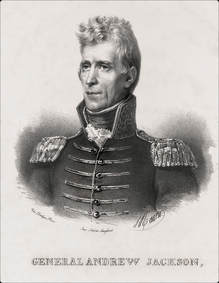 Library of Congress
Library of Congress
Major-general Jackson to the Secretary of War
Head Quarters, 7th Military District
Camped below New Orleans, 27th December, A. M.
Sir,
“The loss of our gun-boats near the pass of the Rigolets, having given the enemy command of lake Borgne, he was enabled to choose his point of attack. It became therefore an object of importance to obstruct the numerous bayous and canals leading from that lake to the highlands on the Mississippi.” Appendix, Historical Memoir of the war in West Florida and Louisiana in 1814-15, Major A. Lacarriere Latour
Head Quarters, 7th Military District
Camped below New Orleans, 27th December, A. M.
Sir,
“The loss of our gun-boats near the pass of the Rigolets, having given the enemy command of lake Borgne, he was enabled to choose his point of attack. It became therefore an object of importance to obstruct the numerous bayous and canals leading from that lake to the highlands on the Mississippi.” Appendix, Historical Memoir of the war in West Florida and Louisiana in 1814-15, Major A. Lacarriere Latour
After the fate of the gun-boats was known to General Jackson, "Mr. J. Shields, purser, and doctor R. Morrell, surgeon of the navy, were sent, on the 15th December, at night, by commodore Patterson, with a flag of truce, to the British fleet, for the purpose of obtaining correct information as to the situation of the officers and crews made prisoners on board the gun-boats,"...... Shields and Morrell, along with their boat and crew, were detained by Admiral Cochrane until after the resolution of the impending battle with the Americans.
"Colonel Denis de la Ronde, who had stationed detachments of his regiment, the third of Louisiana militia, on General Villerie's and Jumonville's plantations, had in the evening of the 22d to inform general Jackson that several sails of vessels had been seen off the point of the three bayous, behind Terre aux Boeufs." Historical Memoir of the war in West Florida and Louisiana in 1814-15, Major A. Lacarriere Latour
About mid-day of the 23rd, "The general ordered me to go, in company with major Tatum, topographical engineer, to ascertain whether this report were true;……… we met several persons flying towards town, who told us that the British had got to general Villerie's house by the canal, and had taken prisoner major Villerie, the general's son." Historical Memoir of the war in West Florida and Louisiana in 1814-15, Major A. Lacarriere Latour
"It being of the utmost importance to inform general Jackson of an event no longer doubtful, major Tatum immediately returned to town, and I proceeded forward as far as over the boundary of La Coste's and Villerie's plantations, whence I discovered British troops occupying the ground……. It was then half past one p. m., and within twenty-five minutes after, general Jackson was informed of the enemy's position. On this the general, with that heroism and prompt decision which is characteristic of him, and of which he had exhibited such signal instances during the campaign, instantly said he would go to meet the British." Historical Memoir of the war in West Florida and Louisiana in 1814-15, Major A. Lacarriere Latour
"Colonel Denis de la Ronde, who had stationed detachments of his regiment, the third of Louisiana militia, on General Villerie's and Jumonville's plantations, had in the evening of the 22d to inform general Jackson that several sails of vessels had been seen off the point of the three bayous, behind Terre aux Boeufs." Historical Memoir of the war in West Florida and Louisiana in 1814-15, Major A. Lacarriere Latour
About mid-day of the 23rd, "The general ordered me to go, in company with major Tatum, topographical engineer, to ascertain whether this report were true;……… we met several persons flying towards town, who told us that the British had got to general Villerie's house by the canal, and had taken prisoner major Villerie, the general's son." Historical Memoir of the war in West Florida and Louisiana in 1814-15, Major A. Lacarriere Latour
"It being of the utmost importance to inform general Jackson of an event no longer doubtful, major Tatum immediately returned to town, and I proceeded forward as far as over the boundary of La Coste's and Villerie's plantations, whence I discovered British troops occupying the ground……. It was then half past one p. m., and within twenty-five minutes after, general Jackson was informed of the enemy's position. On this the general, with that heroism and prompt decision which is characteristic of him, and of which he had exhibited such signal instances during the campaign, instantly said he would go to meet the British." Historical Memoir of the war in West Florida and Louisiana in 1814-15, Major A. Lacarriere Latour
Affair Below New Orleans, December 23rd, 1814
"The greater significance of this battle (23rd of December) and the greater loss to the British was the passage of time allowing General Andrew Jackson to gather more troops and to complete fortifications for the defense at Chalmette where victory over the British was achieved on January 8th." Historical Memoir of the war in West Florida and Louisiana in 1814-15, Major A. Lacarriere Latour
You can click anywhere on the map to zoom view.
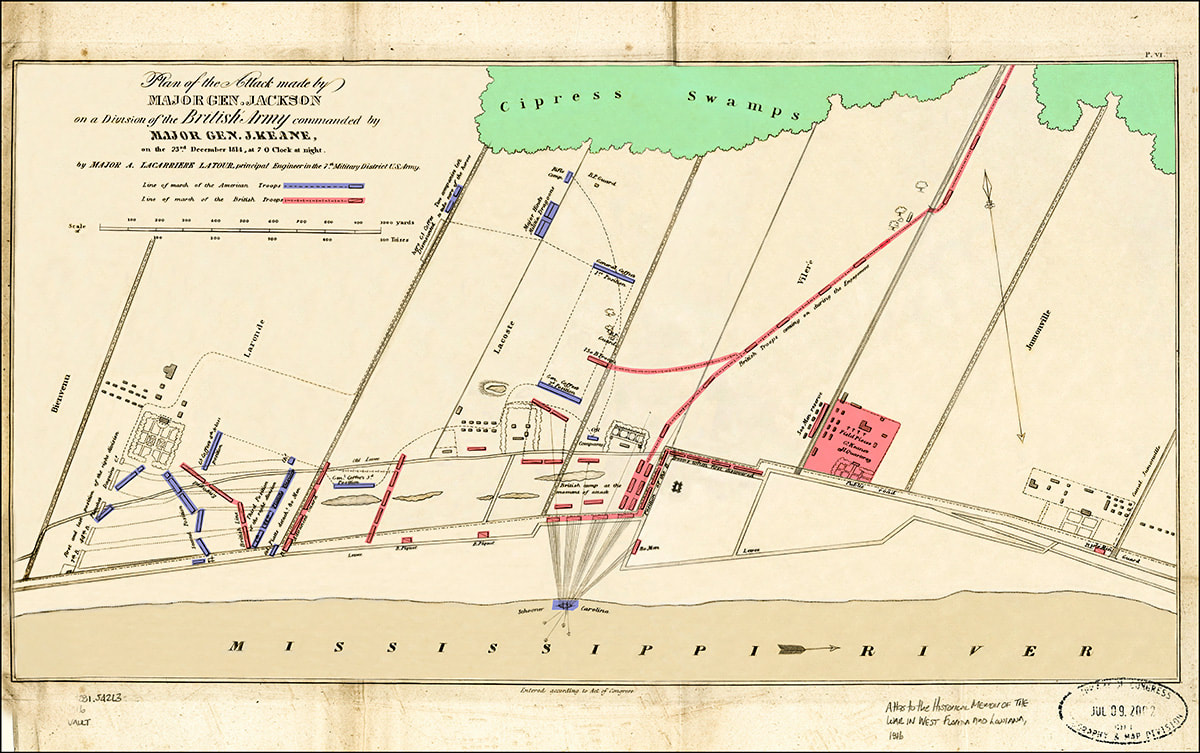 Historical memoir of the war in West Florida and Louisiana in 1814-15, Latour, Arsène Lacarrière, Library of Congress
Historical memoir of the war in West Florida and Louisiana in 1814-15, Latour, Arsène Lacarrière, Library of Congress
On the morning of December 23, General Keane and a vanguard of 1,800 British soldiers reached the east bank of the Mississippi River 9 miles south of New Orleans after marching from Lake Borgne. It was here that the first major blunder of the British campaign was made. General Keane could have marched into the undefended city by advancing for a few hours up the river road, but he decided to encamp at Lacoste's Plantation, rest his troops, and wait for reinforcements.
General Jackson learned of the advanced position of the British and realized he couldn't wait till morning to confront the British forces. General Jackson sent out an order to his commanders to muster their troops. That evening at 7:00 Jackson attacked from the north with 2,131 men in a brief three-pronged assault on the unsuspecting British troops. Jackson then pulled his forces back to the Rodriguez Canal, about 4 miles south of the city. The Americans suffered 24 killed, 115 wounded, and 74 missing, while the British reported their losses as 46 killed, 167 wounded, and 64 missing.
It was General Jackson's decision to strike first that gave Jackson the time to withdraw his forces upriver to within 4 miles of the city. Fortification of the Rodriguez Canal began on the morning of the 24th. The canal became known as the Jackson Line that stopped the British, and forced their retreat back to the Fleet
It was General Jackson's decision to strike first that gave Jackson the time to withdraw his forces upriver to within 4 miles of the city. Fortification of the Rodriguez Canal began on the morning of the 24th. The canal became known as the Jackson Line that stopped the British, and forced their retreat back to the Fleet
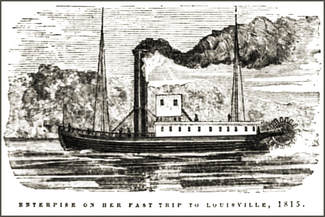
The American Navy bought the USS Carolina in 1812 while her keel was still being laid down in Charleston. It was the Carolina that destroyed Lafitte's stronghold in Barataria Bay near the mouth of the Mississippi River. The USS Carolina slipped down the Mississippi River on the evening of Dec 23,1814, and quietly laid anchor on the opposite side of the river from the British encampment. Her crew began shelling the British troops with grapeshot and cannon balls in what the soldiers thought was going to be a restful night.
"The result of the affair of the 23d was the saving of Louisiana; for it cannot be doubted but that the enemy, had he not been attacked with such impetuosity, when he had hardly effected his disembarkation, would, that very night, or early next morning, have marched against the city, which was not then covered by any fortification, and was defended by hardly five thousand men, mostly militia, who could not, in the open field, have withstood disciplined troops, accustomed to the use of the bayonet, a weapon with which most of the militia were unprovided."
Historical Memoir of the war in West Florida and Louisiana in 1814-15, Major A. Lacarriere Latour
General Jackson also had the support of the Steamboat Enterprise in getting provisions to the American defenses, but the Enterprise also made history by breaking the monopolistic lock on the use of steamboats on America's rivers. The Enterprise was the first commercial vessel to paddle upstream on the Mississippi River from the port of New Orleans to Pittsburg. The Steamboat Enterprise became the symbol for the rapid growth of steamboat commerce on America's western rivers. https://en.wikipedia.org/wiki/Enterprise_(1814)
"The result of the affair of the 23d was the saving of Louisiana; for it cannot be doubted but that the enemy, had he not been attacked with such impetuosity, when he had hardly effected his disembarkation, would, that very night, or early next morning, have marched against the city, which was not then covered by any fortification, and was defended by hardly five thousand men, mostly militia, who could not, in the open field, have withstood disciplined troops, accustomed to the use of the bayonet, a weapon with which most of the militia were unprovided."
Historical Memoir of the war in West Florida and Louisiana in 1814-15, Major A. Lacarriere Latour
General Jackson also had the support of the Steamboat Enterprise in getting provisions to the American defenses, but the Enterprise also made history by breaking the monopolistic lock on the use of steamboats on America's rivers. The Enterprise was the first commercial vessel to paddle upstream on the Mississippi River from the port of New Orleans to Pittsburg. The Steamboat Enterprise became the symbol for the rapid growth of steamboat commerce on America's western rivers. https://en.wikipedia.org/wiki/Enterprise_(1814)
The Events Leading Up To The Battle for New Orleans
 General Pakenham
General Pakenham
General Edward Pakenham arrived on December 25th, and took over command of the British forces. On the 28th a scouting party was ordered by Packenham to determine the strength of the American troops assembled behind the canal. When the British scouts withdrew, the Americans began building earthworks to protect the cannon installations on the Line Jackson. The Americans installed eight canons; a 32-pound gun, three 24-pounders, one 18-pounder, three 12-pounders, three 6-pounders, and a 6-inch mortar. A detachment was also sent to the west bank of the Mississippi to arm the grounded warship USS Louisiana.
General Pakenham, realizing the disadvantage in which the army had been placed, met with General Keane and Admiral Cochrane to plan their attack. General Pakenham wanted to advance up Chef Menteur Road, but Admiral Cochrane believed the veteran British soldiers, and his boats and seamen, could easily take Jackson's ramshackle army. General Packenham was overruled, and the second blunder of the British campaign was made by Admiral Cochrane.
Jackson's force was greatly outnumbered by the British. Jackson's total of 4,732 men was made up of 968 United States Army regulars, 58 United States Marines, 106 seamen of the United States Naval Battalion, 1,060 Louisiana militia and volunteers (including 462 free people of color), 1,352 Tennessee militia, 986 Kentucky militia, 150 Mississippi militia, and 52 Choctaw warriors, along with a force from the pirate Jean Lafitte's Baratarians. Jackson also had the support of the warships in the Mississippi River, including USS Louisiana, USS Carolina and Enterprise, a steamboat.
An artillery bombardment of the American earthworks began when the main British army arrived on New Year's Day, 1815. The artillery exchange lasted for three hours, knocking out 3 of the 8 American canons, and doing considerable damage to the earthworks.
General Pakenham withdrew his troops when the supporting field artillery ran out of ammunition, and decided to wait for his entire force of over 8,000 men to assemble before continuing his attack. The left side of Line Jackson had abandoned their positions under heavy British fire. Had Packenham continued the assault on Line Jackson the battle for New Orleans might have ended badly for the Americans.
Among the British force was 2 West India Regiments of free black soldiers from the British West Indies, and a Native American tribe. https://en.wikipedia.org/wiki/Battle_of_New_Orleans
General Pakenham, realizing the disadvantage in which the army had been placed, met with General Keane and Admiral Cochrane to plan their attack. General Pakenham wanted to advance up Chef Menteur Road, but Admiral Cochrane believed the veteran British soldiers, and his boats and seamen, could easily take Jackson's ramshackle army. General Packenham was overruled, and the second blunder of the British campaign was made by Admiral Cochrane.
Jackson's force was greatly outnumbered by the British. Jackson's total of 4,732 men was made up of 968 United States Army regulars, 58 United States Marines, 106 seamen of the United States Naval Battalion, 1,060 Louisiana militia and volunteers (including 462 free people of color), 1,352 Tennessee militia, 986 Kentucky militia, 150 Mississippi militia, and 52 Choctaw warriors, along with a force from the pirate Jean Lafitte's Baratarians. Jackson also had the support of the warships in the Mississippi River, including USS Louisiana, USS Carolina and Enterprise, a steamboat.
An artillery bombardment of the American earthworks began when the main British army arrived on New Year's Day, 1815. The artillery exchange lasted for three hours, knocking out 3 of the 8 American canons, and doing considerable damage to the earthworks.
General Pakenham withdrew his troops when the supporting field artillery ran out of ammunition, and decided to wait for his entire force of over 8,000 men to assemble before continuing his attack. The left side of Line Jackson had abandoned their positions under heavy British fire. Had Packenham continued the assault on Line Jackson the battle for New Orleans might have ended badly for the Americans.
Among the British force was 2 West India Regiments of free black soldiers from the British West Indies, and a Native American tribe. https://en.wikipedia.org/wiki/Battle_of_New_Orleans
The Battle for New Orleans, January 8th 1815
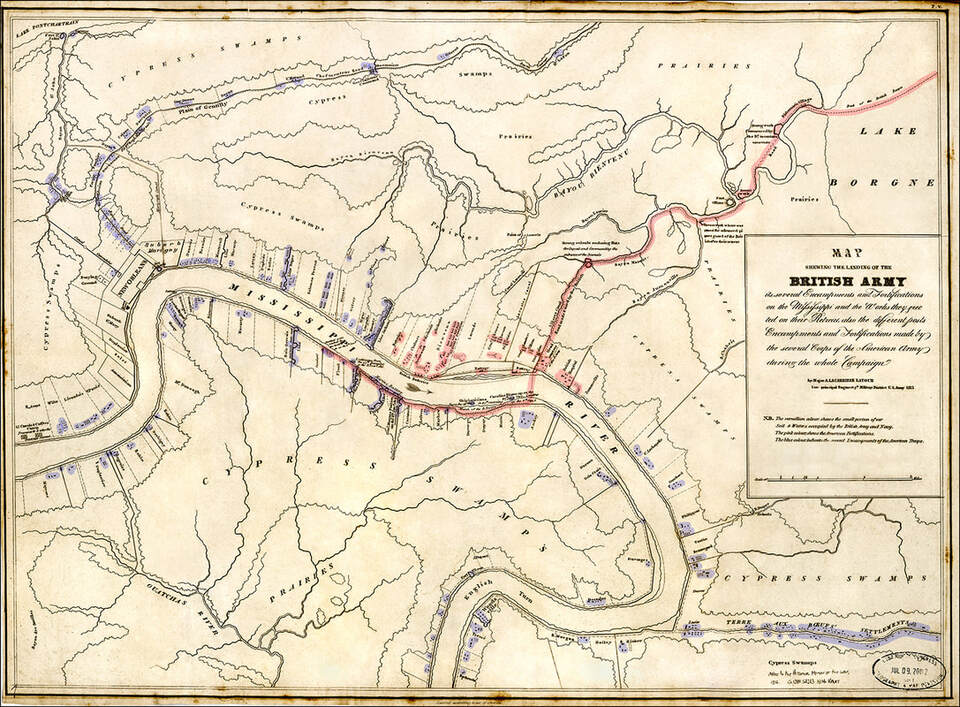 Historical memoir of the war in West Florida and Louisiana in 1814-15, Latour, Arsène Lacarrière, Library of Congress
Historical memoir of the war in West Florida and Louisiana in 1814-15, Latour, Arsène Lacarrière, Library of Congress
You can click anywhere on the map to zom view.
British troop movements and artillery installations from December 27th to the battle formations on the eve of battle on January 8th.
The location of the American gunboat Carolina during the December 23rd night attack on the British forces to the 27th when she caught fire and blew up from red-hot cannon fire from two artillery batteries stationed directly across the river. The American ship Louisiana is towed out of harms way on December 27th, and anchored in support of Line Jackson .
The British troop movements highlighted in red shows the road the British engineers made through the dense marshland and swamp from Lake Borgne to the banks of the Mississippi River on December 23rd. The map also shows the British troop movements during the battle on January 8th when they crossed the river and reached the furthest point of their advance on the city of New Orleans before retreating.
The location of the American gunboat Carolina during the December 23rd night attack on the British forces to the 27th when she caught fire and blew up from red-hot cannon fire from two artillery batteries stationed directly across the river. The American ship Louisiana is towed out of harms way on December 27th, and anchored in support of Line Jackson .
The British troop movements highlighted in red shows the road the British engineers made through the dense marshland and swamp from Lake Borgne to the banks of the Mississippi River on December 23rd. The map also shows the British troop movements during the battle on January 8th when they crossed the river and reached the furthest point of their advance on the city of New Orleans before retreating.
You can click anywhere on the map to zoom in for a better view.
To continue reading an 1885 account of the events leading up to the battle at Line Jackson, go to, Historical Sketch Book
Extreme obstacles faced the British in their campaign to take the city of New Orleans. An assault from the mouth of the Mississippi River was repulsed by fortified American defensive installations at Fort St. Phillip on both sides of the river. The swamp and marshland proved to be more difficult than expected with time lost costing the British the element of surprise. They found themselves hemmed in with the Mississippi River and swamp on their flanks, and Line Jackson blocking their advance on the city. When General Pakenham ordered his troops to advance on the General Jackson's heavily fortified line over open terrain, and they were unmercifully cut to pieces.
Painting and sketch with key by artist jean Hyacinthe Lacotte, 1815
When Pakenham fell in battle along with many of his officers, the British requested a truce to collect the dead and wounded from the battlefield. The Americans helped bury the dead, and took in the British wounded and as it was customary for the victorious side to care for the wounded on both sides. The British used the cease fire to quietly retreat using the same route to get back to their ships. With no trees or other materials for building a road, the British retreat bogged down in the knee-deep mud, adding insult to injury. Winston Churchill said that throughout the history of British battle strategies, the campaign to take New Orleans was the most ill planned.
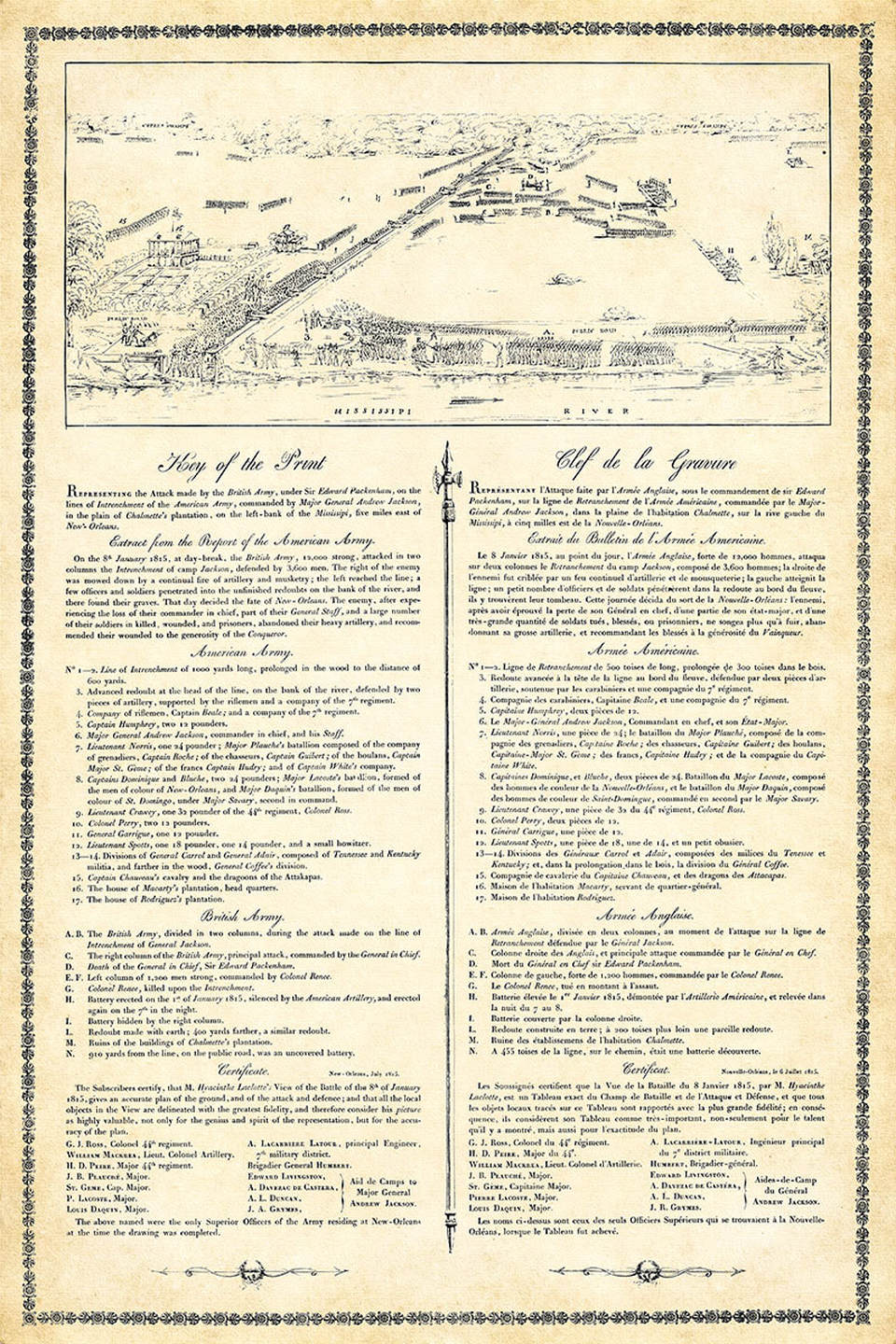 Original sketching of the battlefield printed with a key identifying the essential features of both armies by artist jean Hyacinthe Laclotte, [1815?]
Original sketching of the battlefield printed with a key identifying the essential features of both armies by artist jean Hyacinthe Laclotte, [1815?]
To continue reading an 1885 account of the events leading up to the battle at Line Jackson, go to, Historical Sketch Book
Print (above) made from engraving is an allegorical reference to the Treaty of Ghent which ended the war 1812, showing Minerva dictating the terms of peace, which Mercury delivers to Britannia and Hercules compels her to accept. The monument on the left is similar to the Chalmette battle field monument for the Battle of New Orleans that can be seen in the photograph below.
Glass plate photographs form the Detroit Publishing Co. collection
The Youth's Companion (1827–1929) was a children's magazine in print for over one hundred years. On September 8, 1892, the magazine published the first copy of the Pledge of Allegiance, written by staff member Francis Bellamy.
Francis Julius Bellamy (1855 –1931) wrote the original version of the U.S. Pledge of Allegiance. Bellamy was a Christian socialist who "championed 'the rights of working people and the equal distribution of economic resources, which he believed was inherent in the teachings of Christianity.
In 1888, the Youth's Companion magazine became a supporter of the school flag movement, and in 1891, Bellamy was hired by Youth's Companion to organize a campaign to sell U.S. flags to public schools to boost subscriptions. By 1892, the magazine had sold U.S. flags to approximately 26,000 schools.
During the 400th anniversary of Christopher Columbus reaching the Americas, the magazine called for a national public school celebration. A flag salute was to be part of the official program to be held in schools all over the United States.
Francis Bellamy's pledge was published in the September 8, 1892 issue of Youth's Companion. Bellamy won the support of school superintendents, and the National Education Association, for an official program for schools to follow, and structured a program around a flag-raising ceremony and his pledge.
His original Pledge reads:
I pledge allegiance to my Flag and to the Republic, for which it stands, one nation, indivisible, with liberty and justice for all.
https://en.wikipedia.org/wiki/Francis_Bellamy
Francis Julius Bellamy (1855 –1931) wrote the original version of the U.S. Pledge of Allegiance. Bellamy was a Christian socialist who "championed 'the rights of working people and the equal distribution of economic resources, which he believed was inherent in the teachings of Christianity.
In 1888, the Youth's Companion magazine became a supporter of the school flag movement, and in 1891, Bellamy was hired by Youth's Companion to organize a campaign to sell U.S. flags to public schools to boost subscriptions. By 1892, the magazine had sold U.S. flags to approximately 26,000 schools.
During the 400th anniversary of Christopher Columbus reaching the Americas, the magazine called for a national public school celebration. A flag salute was to be part of the official program to be held in schools all over the United States.
Francis Bellamy's pledge was published in the September 8, 1892 issue of Youth's Companion. Bellamy won the support of school superintendents, and the National Education Association, for an official program for schools to follow, and structured a program around a flag-raising ceremony and his pledge.
His original Pledge reads:
I pledge allegiance to my Flag and to the Republic, for which it stands, one nation, indivisible, with liberty and justice for all.
https://en.wikipedia.org/wiki/Francis_Bellamy

